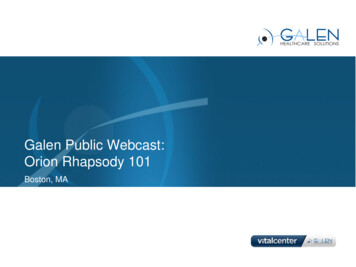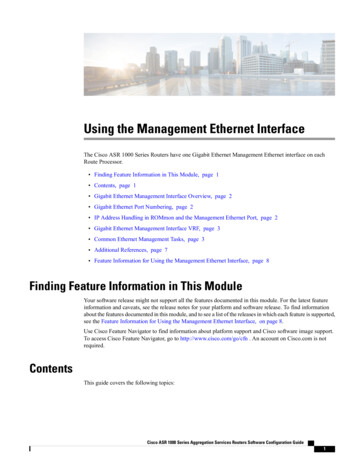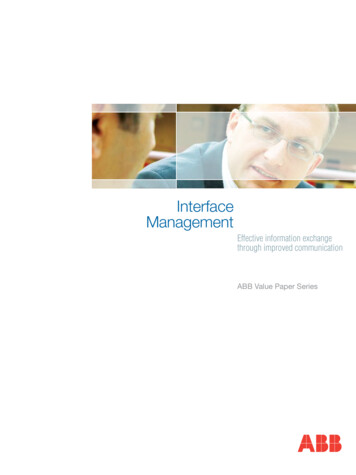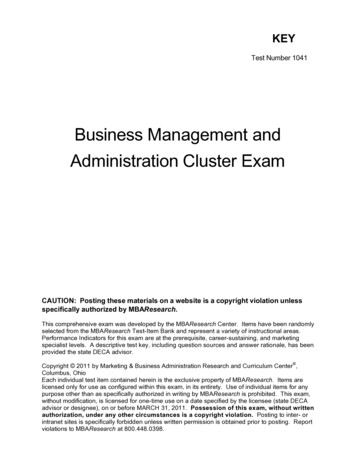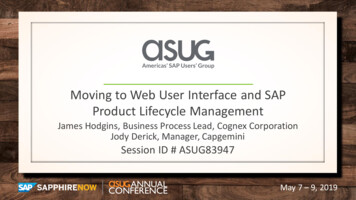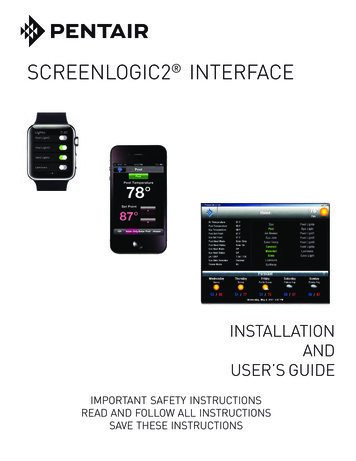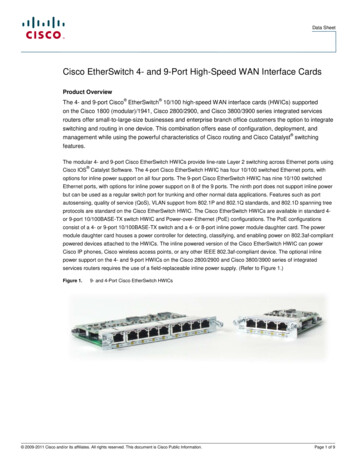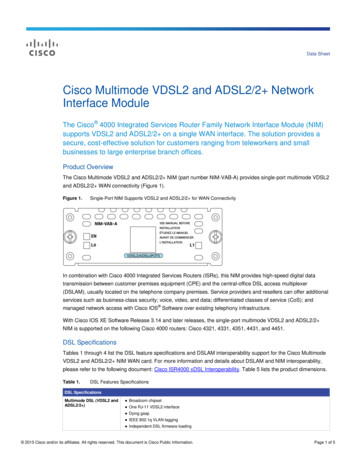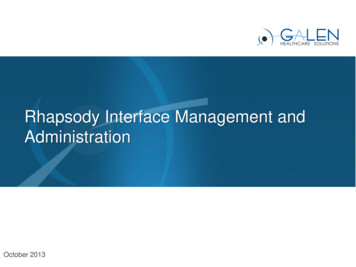
Transcription
Rhapsody Interface Management andAdministrationOctober 2013
Welcome The Rhapsody Framework– Rhapsody Processing Model– Application and persistence store files Web Management Console– Backups– Route, communication and message detail pages Monitoring and Management Engine Management, Best Practices and Common Performance Issues Users and Groups Notifications and Watch Lists Q&A – Chat and LiveOctober 2013
Rhapsody Processing Model Communication points– Each communication point is optimized to support Routes– Filters Input/Output Connectors No match connector Error connector– Connectors Standard Connector Conditional Connector Javascript ConnectorOctober 2013
Rhapsody Message Pathway1. Message is received by the communication point2. Message is persisted to the disk3. Message entered into relevant input queues4. Reference retrieved from input queue by the route and added to theroute queue5. Object model of message built6. Message passes through filters7. Message is placed into the output queue(s) for the outputcommunication point(s) to transmit.October 2013
Filter Processing1. Message enters filter2. Reference added to transaction log3. Changes made to message properties are persisted to disk4. Filter Processing complete5. Output path/s determined6. Next processing component/s identified and route queue updated7. Reference closed in transaction logOctober 2013
Application File Layout bin: contains the Rhapsody startup files. equinox: contains support libraries and logs for those libraries. jre: contains the Java Runtime binaries that are used in the specificversion of Rhapsody licenses: contains third party license detail for libraries used withinRhapsody. log: contains the text log files for the service wrapper and forRhapsody. plugins: contains the Rhapsody Java library files. rhapsody: contains the run-time configuration file for Rhapsody aswell as the engine license and log configuration; also contains thedefault location for the Rhapsody persistence store (data/). run: process details for a running engine. tools: support tools which may be required as standalone applications.October 2013
The Persistence Store The persistence (or data) store is a single repository with two primarypurposes:1. As a repository for active messages and their associated metadata.2. As a repository for historical messages The persistence store does not differentiate between active messagesand messages for which processing has been completed The size of the persistence store is managed to constrain the size ofthe archive Messages older than the limit of the archiving period are normallybacked up to system storage devices.October 2013
Archive Cleanup Process Once message processing is complete and no updates are written tothe store the messages are available for historical analysis The persistence store can grow at a rate of 30-50 GB per day in highload environments The archive cleanupservice can be configured toensure that disk limits arenot exceededOctober 2013
Web Management Console Monitoring and control tool for the Rhapsody engine. https:// server name :8444 http:// server name :8081 Landing page of the Web Management Console is the Engine Monitorpage under the Monitoring menu Engine Monitor provides a snapshot of the Engine Uptime, totalMessages Processed and message Throughput for the Rhapsodyengine.October 2013
Backups Backups can be scheduled on a full or incremental cycle Forensic restores allow a non-production engine for analysis purposes Backup schedules may be defined for– Administration components: notably the user store and schedulesfor backup and cleanup– Configuration: the engine configuration including watch lists,notifications and tracking schemes– Message store including the active messaging and logs– All: the complete engine state Good practice model- weekly full back up followed by nightlyincremental backupsOctober 2013
Route Details Provides a summary view of all routes in the system, including theircurrent state, traffic and processing load. Waiting column provides a numerical indicator of any messagesqueuing on the route Currently Processing column is an indicator of messages that have notyet completed processing Route Details - lists all Input and Output communication pointsassociated with this route, along with any filters that may be present Ability to view throughput of route Warnings or Alarms - lists potential problems and issuesOctober 2013
Communication Point Details Top section identifies whether the communication point is running ornot and includes a link to changing this status Warnings or Alarms - lists potential problems and issues Ability to view Notification Settings Link to view messagesOctober 2013
View Messages The message view has four sections1. Message Events - lists the path which the message has followedas it traverses the engine2. Event Tree-allow for navigating within the Message Events tree3. Message Properties - displays a read-only list of the properties(meta data) associated with the message at each stage of itsprocessing4. Message Body - displays the content of the message The download link at the bottom left of the panel saves the messagelocally– These messages can then be viewed in another application suchas HL7 spyOctober 2013
Handling Message Errors Unhandled processing errors result in the associated messages beingplaced onto the Error Queue Messages listed on the Error Queue can be selected for furtherprocessing– Reinject - The message is reinjected into the engine at its originalpoint of entry– Edit-allows you to edit the message before redirection– Redirect - The message is redirected to a selected filter orcommunication point.– Reprocess - The message is sent back to the filter on which theerror originally occurred– Delete - The message is removed (deleted) from the queue and noadditional processing is performed on the message– Download - The message is downloaded as a compressed fileOctober 2013
Message Searching Web Management Console provides the ability to search for messagesheld in the persistence store, including messages which are still activeand have not yet completed processing The Find Messages section of the WMC menu provides a number oftemplates for search operations and also provides for re-use ofcommon query structures:– Input Search: standard template for locating messages by the inputcommunication point– Output Search: standard template for locating messages whichhave completed processing– Route Search: standard template for locating messages by route– Saved Searches: a search may be saved for re-use– Recent Results: presents a list of the 10 most recent searchesOctober 2013
Monitoring Engine Health A well managed Rhapsody instance has high reliability and is not likelyto require system attention. Continuous uptimes in excess of 400 daysis not unusual Traits of a healthy engine system– Is configured defensively to ensure that processing exceptions arerapidly noted and acted upon– Utilizes memory effectively and has sufficient spare disk capacity tocomfortably manage the work load– Ensures that information placed in log files efficiently reports issues– Maintains small to non-existent queues– The volume of logging is sufficiently low so that significant issuesmay be readily identified rather than being difficult to locate due tothe volume of loggingOctober 2013
Common Performance Issues “Random” restarts– Examination of the logs normally reveals numerous communicationpoint failures prior to the restart are present in the System log Startup failure– Engine already running– Bind issues– Data Store corruption Slow processing– Abnormally heavy message load, resulting in queuing– Additional activity on the host– Insufficient host memory resulting Blocking route threads due toslow filter processingOctober 2013
Log Levels The operation of the Rhapsody environment is continually monitored bythe logging components and events are reported as they occur Five different log level– FATAL: report only fatal (very severe) events– ERROR: report only error and fatal events– WARN: report warnings, errors and fatal events– INFO: include information events in the logs as well– TRACE: provide trace level logging as supported by the underlyingcode– DEBUG: provide more detailed information on the events normallyuseful for application debugging
Users Assigning users provides many benefits for organizations– Permits the creation of user accounts with limited access toRhapsody– The ability who has a Rhapsody component checked out– The ability to tailor the way each user receives notifications fromthe Rhapsody elements they have been subscribed to– Users and Groups are managed from the Rhapsody IDE via theUser ManagerOctober 2013
Groups The list of Access Groups is accessible by clicking the Groups buttonon the User Manager An administrator is able to add a new, modify an existing scheme ordelete an access group when no longer required
Tasks and Responsibilities Maintaining and managing a Rhapsody site generally requires threegroups of activities.– Site Administration tasks: responsible for the server and integrationwith site networks– Analyst / Developer: responsible for building and managing theconfiguration and ensuring the correct operation of interfaces– Monitoring / support: responsible for monitoring the state of thesystem and first point of contact for issuesOctober 2013
Access Schemes Login to IDE - provides read access to the Rhapsody IntegratedDevelopment Environment (IDE). Login to Web Management Console - provides read access to theManagement Console. Call the Rhapsody Web Services API - can call operations in theRhapsody Web Services API.October 2013
Notification Schemes View Default Notification Settings - can view the Default Settings page fornotifications. Suspend and Resume Component and Issue Notifications - can suspendand resume the notifications of components and issues from the Suspend /Resume All notifications page. Notification stream comment - can make comments in the notification stream. Notification issue resolve - can resolve notification issues. Notification issue assign - can assign notification issues. Notification flag comment - can flag comments in the notification stream asimportant. Edit Current User's Notification Preferences - can access and edit the MyNotifications section for the current user. Send test notifications - can send test notification messages. Edit Watch Lists - can edit Watchlists. Edit Component Notifications - can change notification recipient andescalation resend periods for components from the Resend and EscalationPeriods section in the Management Console.October 2013
Notification Schemes Continued Edit Unmonitored Component Notifications - can edit component notificationthresholds from Notifications for Unmonitored Components section. Edit Component Notification Thresholds - can customize notificationsthresholds for components from the component details page in the ManagementConsole. Edit Default Notification Thresholds - can edit default notifications thresholdsfrom the Default Threshold Settings section. Redirect User Notifications - can redirect user notification while they are onholiday. Edit Notification Delivery Methods - can enable, disable and configure theDelivery Methods available for delivering notifications. Suspend and Resume Global Notifications - can suspend and resume allcomponent and issues notifications across the engine. Edit Other User's Notification Preferences - can access and edit the MyNotifications Section page for other users. Edit Public Holidays - can add, remove, import and export public holidays fromthe Public Holidays page.
Notifications The issue event– Warning-indicates an issue considered relatively benign butrequires attention (ops team receive emails)– Alarm-indicates an issue which requires immediate attention (TeamLead receives SMS)– Escalation-indicates an issue raised in an Alarm state which hasnot been resolved in a defined time period (Manager) Managing Notification Delivery– Email, SMS via an Email bridge, Pager via an Email bridge, SNMP Default Notifications Default Thresholds– Trigger Event– ThresholdOctober 2013
Watch Lists Building and managing a watch list– Each watchlist may be managed by clicking on its link on theNotifications / Watchlists page Management of the recipient list for notifications Management of the components associated with the list. Building a watch list schedule Watch lists and public holidays Watch lists and user schedules– The vacation support is available in the My Leave section of theNotifications / My Notifications page for the userOctober 2013
Why Integrate to 3rd Party Monitoring There is already an enterprise wide monitoring system in use There are many Rhapsody engines that need to be monitored Rhapsody ‘push’ based notifications can not notify if something criticalhappens Options– Restful API– Rhapsody Watchlist Notifier– Web Services APIOctober 2013
Best Practices– Ensure the persistence store is maintained in a secure environment– Ensure the archive cleanup parameters are correctly defined, and thatmessage queues are dealt with efficiently– Ensure that disk usage is monitored– Understand the purpose of backups and implement appropriately– Establish procedures for Disaster Recovery and restoration of theconfiguration– Ensure the configuration is tuned to minimize the volume of loggingOctober 2013
Thank you for joining us today, for additionalassistance .You can contact us through our websiteat www.galenhealthcare.comOctober 2013
Disk, Heap and CPU Utilization
Rhapsody Threads Route Execution Threads1. Route executor thread becomes free2. Next processing transaction assigned to the thread3. Transaction starts and message is processed4. Transaction complete and route executer thread becomes free Message Collector Timeout Threads– manage the timeout states of messages held by the messagecollectors Administration Threads– manage the communications with connected IDE sessions ( Communication Point Threads– The Controller thread monitors the operation of the communicationpoint and manages the behavior if the connection fails– The Connection threads manage the sending and receiving ofmessages, the number of threads used being dependent on themode and the number of connections configured
Engine Startup Processes Active Processes– Wrapper– The Rhapsody JVM The Tanuki Wrapper– manages the engine startup and shutdown processes and ensuresthat the engine remains responsive by sending a service ping to theengine every second Normal Startup– 1. Start webservices 2. Start the core Rhapsody service 3. Loadmodules 4. Roll back transactions which may have been in processwhen the engine last stopped 5. Start components as defined bythe startup state defined for each 6. Resume normal processing.
Retry Management Rhapsody provides a range of tools to manage communicationpoint connections, and more significantly, connection failure.– Immediate retry: suitable for protocols where the target is expectedto be permanently available with no need to delay connectionattempts– Linear retry: suitable for protocols such as network protocols wherea connection failure may result from a transient outage lasting ashort period, the re-connection attempt being made at regularintervals.– Exponential retry: suitable for protocols where the target may haveirregular and unknown outages, the re-connection attempts beingmade at successively longer intervals until connection is achieved;the utility of this method may be lost as the interval grows.
The Persistence Store The default location for the persistence store is in therhapsody/data folder in the application folder tree– Backup and cleanup: schedule details for configured backups andcleanups– config: the Rhapsody configuration head: the persisted version of the configuration running: the currently running version of the configuration– lib: user modifiable; support libraries required for filters may beplaced here (for example JDBC drivers). The engine checks thislocation regularly for new libraries.– logs: binary event and audit log data, accessible through the logpages in the WMC the data/ folder also contains the engine.version andengine.running files
Application File Layout bin: contains the Rhapsody startup files. equinox: contains support libraries and logs for those libraries. jre: contains the Java Runtime binaries that are used in the specific version of Rhapsody licenses: contains third party license detail for libraries used within Rhapsody. log: co


